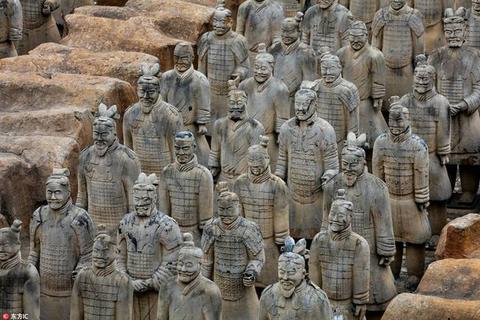
How Many Terracotta Warriors Are There?
The Eighth Wonder of the World
Referred to as the eighth Wonder of the World, the Terracotta Army is a sight to behold. Discovered in 1974 by farmers digging a well in Lintong District, Xi'an, Shaanxi province, China, the army consists of thousands of life-size terracotta figures that were buried with Qin Shi Huang, the first emperor of China, in 210–209 BCE. The figures were meant to protect the emperor in the afterlife.
A Massive Army
The Terracotta Army is a vast collection of terracotta figures, with estimates suggesting there are over 8,000 soldiers, 130 chariots with 520 horses, and 150 cavalry horses, most of which remain buried in the pits near Qin Shi Huang's mausoleum.
The figures are life-sized and realistically detailed, with unique facial features, hairstyles, and armor. They are arranged in battle formation and are armed with a variety of weapons, including swords, spears, and crossbows. The army is a testament to the power and wealth of the Qin dynasty, as well as the skill of the ancient Chinese artisans who created them.
Exploring the Pits
The Terracotta Army is divided into three main pits, each with its own unique features:
-
Pit 1: This is the largest pit and contains the main army, with over 6,000 soldiers arranged in battle formation. The soldiers are armed with a variety of weapons and are accompanied by chariots and horses.
-
Pit 2: This pit contains a more diverse group of figures, including archers, cavalry, and chariots. It is believed to represent the military might of the Qin dynasty.
-
Pit 3: This is the smallest pit and contains high-ranking officers and a command post. It provides insights into the military organization of the Qin army.
Ongoing Excavations
While thousands of warriors have been unearthed and assembled, a large portion of the Terracotta Army remains buried underground. Archeologists continue to excavate and study the site, with new discoveries being made regularly. The ongoing work is shedding light on the manufacturing processes, military tactics, and cultural practices of the Qin dynasty.
FAQ
Q: How many Terracotta Warriors are there?
A: While the exact number remains unknown, estimates suggest there are over 8,000 Terracotta Warriors, along with numerous horses and chariots, within the three pits.
Q: Can you visit the Terracotta Army?
A: Yes, the Terracotta Army is open to the public. The museum complex surrounding the excavation site is a popular tourist destination.
Q: Why were the Terracotta Warriors built?
A: The Terracotta Army was constructed to accompany Qin Shi Huang, the first emperor of China, in the afterlife, providing him with protection and companionship in the spiritual realm.
note: This return of all, without the author's permission, may not be reproduced